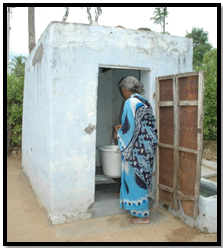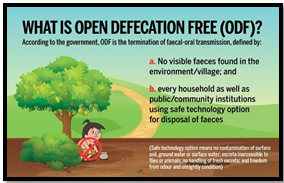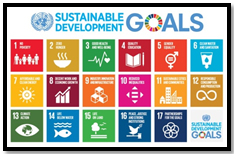A CRITICAL VIEW OF THE ‘SANITATION MIRACLE’ IN RURAL INDIA
Relevance:
GS 2
- Government policies and interventions for development in various sectors and issues arising out of their design and implementation.
Why in News:
- The government needs to identify the shortcomings in the existing programme if it wants to transform India from open defecation free to open defecation free-plus status by 2024-25
Source- The Hindu
In recent years, India has made significant strides in improving sanitation coverage, aligning with the United Nations’ Sustainable Development Goal 6. This transformation has been driven by various public sanitation initiatives, culminating in the Swachh Bharat Mission-Grameen (SBM-G), aimed at making India Open Defecation Free (ODF) by October 2019. Despite remarkable achievements, there are critical aspects that warrant examination, particularly concerning behavioral patterns, disparities, and the need for holistic planning.
Open Defecation Free Status (ODF): ODF status is achieved when, at any time during the day, no individuals are observed defecating in open areas. ODF+ Status: ODF+ status is attained when, throughout the day, no individuals are found defecating or urinating in open spaces, and all community and public toilets are operational and well-maintained. ODF++ Status: ODF++ status is granted when an area has already achieved ODF+ status and ensures safe management and treatment of faecal sludge/septage and sewage, preventing any discharge or dumping of untreated faecal sludge and sewage into open drains, water bodies, or surrounding areas. |
Data and Behavioral Patterns
- Sanitation coverage surged from 39% in 2014 to 100% in 2019, but behavior change is vital for sustainability.
- Some individuals do not use available toilets due to reasons like lack of superstructure, malfunctions, unhygienic conditions, or personal preferences.
- Regional disparities exist, with varying levels of toilet access and usage in Bihar, Gujarat, and Telangana.
- Quality issues, such as collapsed sub-structures and full pits, contribute to non-usage.
- Social norms and cultural factors influence toilet utilization, leading to alternative uses like storage, bathing, or clothes washing.
Disparities and Challenges
- Survey variations highlight disparities, indicating the need to address households left out.
- Household size, access to water, and the absence of attached bathrooms affect toilet usage.
- Phase II of SBM-G lacks criteria for multiple toilets in larger households and does not address attached bathrooms.
- Social norms, caste hierarchies, and network dynamics impact sanitation behavior.
- Upper castes tend to have better access to toilets, while behavioral change campaigns should consider the diversity of networks across villages.
Lack of Synergy and Coordination
- The initial phase of SBM-G saw the construction of numerous toilets and raised awareness.
- Collective behavioral change requires coordinated efforts, improved living standards, and access to basic services.
- India’s fragmented approach to fulfilling basic needs lacks overall planning and coordination.
- Uncoordinated efforts can lead to inefficient utilization of public finances.
Recommendations
- Behavioral Change Priority: Focus on promoting behavioral change alongside toilet construction, addressing cultural norms and practices.
- Equity in Access: Target regions with low sanitation coverage to ensure equal access to toilets across all areas.
- Synergy Across Programs: Enhance coordination between programs addressing basic needs like housing and water supply to maximize efficiency.
- Data-Driven Decisions: Continuously monitor and analyze data to identify program shortcomings and adjust strategies accordingly.
- Public Awareness: Invest in public education to emphasize sanitation’s importance and encourage proper toilet usage.
- Community Engagement: Encourage communities to take ownership of sanitation facilities for long-term sustainability.
To achieve Open Defecation Free-Plus status by 2024-25, the Indian government must address behavioral challenges, disparities, and the lack of program synergy. Focusing on social norms, network dynamics, and coordinated efforts is essential for long-term success in rural sanitation initiatives.
Sustainable Development Goals (SDGs)
· The United Nations (UN) introduced the 2030 Agenda for Sustainable Development and the Sustainable Development Goals (SDGs) as a means to promote sustainable development globally. · This comprehensive agenda is universal, integrated, and transformative, with the overarching goal of eradicating poverty and fostering sustainability within the next 15 years. · The 2030 Agenda comprises 17 distinct goals, each associated with 169 specific targets that must be accomplished by 2030. · Achieving these goals necessitates collaborative efforts from various stakeholders, including governments, businesses, civil society, and individuals worldwide. · It’s important to note that SDGs are not legally binding, emphasizing the voluntary nature of global cooperation in pursuit of sustainable development. |
| Swachh Bharat Mission Grameen (SBM-G): An Overview
Swachh Bharat Mission Grameen (SBM-G) is a significant initiative launched in 2014 by the Ministry of Jal Shakti with the aim of accelerating efforts to achieve universal sanitation coverage and prioritizing sanitation in India’s rural areas. This mission was designed as a nationwide campaign, often referred to as Janandolan, with the primary objective of eradicating open defecation in rural regions. Swachh Bharat Mission (G) Phase-I and II: Achievements · At its inception in October 2014, the rural sanitation coverage in India stood at 38.7%. · Subsequent to the launch of SBM-G, more than 10 crore individual toilets were constructed, leading to the declaration of rural areas in all states as Open Defecation Free (ODF) by October 2, 2019. · SBM(G) Phase-II: Sustainability and Solid/Liquid & Plastic Waste Management (SLWM) · Phase-II of SBM-G places significant emphasis on sustaining the achievements of Phase-I and enhancing the infrastructure for Solid/Liquid & Plastic Waste Management (SLWM) in rural India. · This phase, spanning from 2020-21 to 2024-25, is executed as a mission mode project with a total budget allocation of Rs. 1,40,881 crores. · The SLWM component of ODF Plus will be closely monitored, focusing on key areas such as plastic waste management, biodegradable solid waste management (including animal waste management), greywater (household wastewater) management, and fecal sludge management. Top Performing States · Telangana, Tamil Nadu, Odisha, Uttar Pradesh, and Himachal Pradesh are recognized as the top five performing states under SBM-G, where a substantial number of villages have successfully achieved the ODF Plus status. |
Source
The Hindu
Mains Question
Discuss the achievements and challenges of India’s rural sanitation initiatives, with a particular focus on behavioral patterns, regional disparities, and the need for coordinated efforts. What measures should the government take to ensure the sustainable success of sanitation programs in rural India?

 Source- The Hindu
Source- The Hindu Source: India today
Source: India today Source:- UN
Source:- UN

